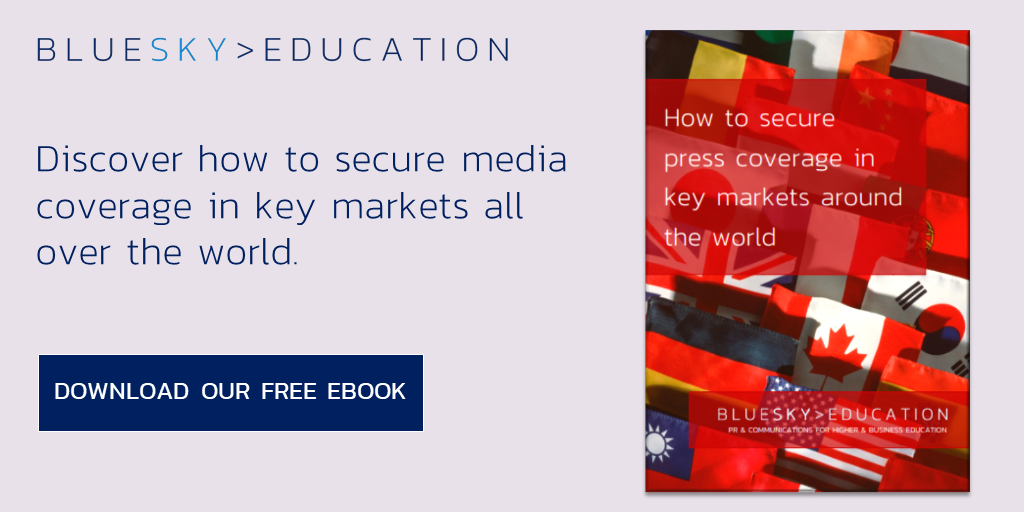You might be well-versed when it comes to PR in your local country; you know which publications to target with which story and have already built relationships with a number of local journalists, but when it comes to gaining coverage internationally, it might take a little something extra for you to grab their interest and secure that op-ed, comment, or interview.
Here are some tips on how to develop an international PR strategy:
1. Know your target
Whether you’re targeting the US, Germany, France, or China, you need to familiarise yourself with the media in that country: look into which publications are most popular and most read, as well as which publications target the audiences you want to hit. For example, if you have a professor who can comment on Chinese students travelling to study abroad, you need to make sure you target a publication that would be interested in this.
2. Build relationships
If you want your client to gain exposure in another country, then try to build relationships with local journalists. Select target media from your chosen country, familiarise yourself with its content and readership, and research into which journalists work for those publications. Then provide them with consistently relevant content for their outlet. If you continue to do this, you can build a rapport with international journalists and prove to them that you are a reliable source for content and spokespeople. This increases the chances of them approaching you for content in the future.
At the heart of media relations in China is the concept of Guanxi – building a relationship. This involves devoting time to nurture important relationships. What sets Guanxi apart from the types of networks we are used to in the West is the strong sense of obligation inherent within it. Favours are always returned, possibly in the short term, possibly much, much later on, but the initial act is never forgotten.
3. Use comparisons that resonate
How would you best describe your institution to a US market that is likely to be unfamiliar with leading universities and business schools beyond Oxford, Cambridge, or UCL? You might want to start with a description of your institution comparing them with a major local player. Perhaps your school can be described as the ‘MIT of Europe.’ But remember, if you claim this, you have to back it up in your pitch. Really demonstrate to your target market that your client’s faculty are world-class academics with important, relevant, and interesting research or opinions.
4. Current and relevant developments
There’s no point pitching a professor’s views on the UK political system to a China-focused outlet. Unless they are catering for an audience interested in UK politics, they probably won’t care. You need to ensure that your story or pitch is current and relevant to your target country.
For example, perhaps you want to target US media with research on negotiations which used German politicians. This might not resonate with a US audience, however, if the researcher can generalise the findings to comment on negotiations in US politics then you may have a much greater chance of success. After all, the entire world has their eyes on the US election and expert insight into US politics, especially a certain Mr. Trump, would be of global interest.
5. Global issues
Another way to ensure a story is relevant is to tap into current global issues and any developments as they happen.
Unless you have been living on another planet, you’re fully aware the entire world has been in the grips of a global health crisis: COVID-19. This pandemic has impacted a whole host of sectors which changes constantly, and universities are full-to-the-brim with faculty that can provide expert comment on these impacts: How the pandemic has affected global supply chains, the impact of travel restrictions on international education, or the psychology of panic-buying. There is no shortage of areas affected by the pandemic or experts you have access to that can comment on them.
Another constantly developing topic which effects the entire world, is global warming and environmentalism. The impact humans are having on the planet – rising temperatures, increased wildfires, air pollution, wildlife recovering after diminished human activity during the pandemic – these are areas which media are interested in internationally as it affects everyone.
6. Use inspirational role models
International students, alumni, and faculty are ideal spokespeople to demonstrate a connection with your target media market. For example, if you want to gain coverage through a US publication, then you can do this through using the experiences of American students at your institution, whether that’s in France, Kazakhstan, or Germany. Alternatively, you could also use professors teaching at your institution that are originally from your target country: a French professor teaching at a school in the UK could be a great spokesperson for a story on how UK higher education differs to French higher education in a French outlet.
7. Demonstrate the global appeal of your research
Research is one of the many ways to secure coverage for a higher education institution in the media. However, publications won’t be much interested if the research isn’t relevant to their country. For example, a Chinese publication isn’t going to be interested in research which finds science imagery is biased towards representing men as scientists in European countries. If you want research like this to appeal internationally then you need to emphasise how this can be applied to your target country. Is the professor able to comment on the application of these findings to gender bias in Asia or China specifically?





